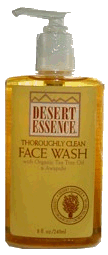Toxic Formaldehyde: Lurking in All These Secret Household Locations!
by SixWise.com
Formaldehyde, the colorless, strong-smelling gas often associated
with embalming fluid or preservatives in medical labs, is
much more commonly used than most consumers realize.
In fact, chances are high that you've already inhaled or
absorbed some today just by going about your morning routine.
The idea of brushing your teeth or washing your hair with
formaldehyde-infested products is unpleasant, to say the least,
but it's also a real health danger.
Formaldehyde, according to the International
Agency for Research on Cancer, is a toxic cancer-causing substance
(the U.S. Environmental Protection Agency (EPA) classifies
it as a probable human carcinogen).
|

It sure looks nice ... but this room is largely
made of medium-density fiberboard (MDF), which the EPA
says emits more formaldehyde fumes than any other pressed
wood product.
|
The primary ways people are exposed to this poisonous substance
is by inhaling its vapors from the air or absorbing liquids
that contain it through the skin. Here are some of the common
sources that may be in your home:
-
Personal care products (shampoo, toothpaste, mascara,
air fragrances, aftershave, cosmetics, nail polish)
-
"No-iron" durable-press clothing, fabrics and
draperies
-
Plywood and particleboard used to build homes
-
Medium-density fiberboard (MDF) used for cabinets and
furniture
-
Glues and adhesives
-
Paints and coatings
-
Certain insulation materials (urea-formaldehyde foam
and fiberglass)
-
Automobile emissions
-
Emissions from burning wood, kerosene or natural gas
-
Cigarette smoke
How Much Formaldehyde Does it Take to Cause Health Issues?
According to the U.S. Consumer Product Safety Commission
(CPSC), as few as 0.1 parts per million
(ppm) of formaldehyde in air can cause watery eyes, burning
sensations in the eyes, nose and throat, stuffy nose, nausea,
coughing, chest tightness, wheezing, skin rashes and allergic
reactions. The EPA says, "It has also been shown
to cause cancer in animals and may cause cancer in humans."
And as with most chemicals, whereas some people will have
a relatively high "tolerance" and not show noticeable
symptoms when exposed, others may be extremely sensitive.
There have been documented cases of people who have had allergic
or asthmatic reactions to formaldehyde just from wearing durable-press
clothing that contains the substance.
 No-iron
pants and shirts may save you time ironing, but they also
outgas formaldehydes fumes for you to inhale throughout
the day. No-iron
pants and shirts may save you time ironing, but they also
outgas formaldehydes fumes for you to inhale throughout
the day. |
Although CPSC says that formaldehyde levels in indoor and
outdoor air are usually less than 0.03 ppm, this level can
vary tremendously depending on the products in your home.
One of the biggest concerns comes from pressed wood products
made using adhesives that contain urea-formaldehyde (UF) resins.
The worst of these is medium-density fiberboard (often used
for drawer fronts, cabinets and furniture tops), as it's known
to emit more formaldehyde fumes than any other pressed wood
product.
Fortunately, since 1985 the Department of Housing and Urban
Development (HUD) has required that prefabricated and mobile
homes be built only from plywood and particleboard that conform
to specified formaldehyde emission limits, however homes built
prior to this had no such standards.
Another concern is urea-formaldehyde foam insulation (UFFI)
that was widely used in the 1970s. According to the EPA, many
homes with this insulation were found to have high indoor
levels of formaldehyde. Few homes use this product today,
however, and UFFI formaldehyde emissions decline over time
so older homes with UFFI are not likely to be emitting high
levels today.
How to Reduce Your Exposure to Formaldehyde
Alarmingly, even with the newer safeguards in place, the
EPA says that, "In homes with significant
amounts of new pressed wood products, levels [of formaldehyde]
can be greater than 0.3 ppm." Remember that CPSC
found health effects occurred with levels as low as 0.1 ppm.
The EPA also says that, "Average concentrations in older
homes without UFFI are generally well below 0.1 ppm."
But what about homes that do have UFFI or a combination of
UFFI and pressed wood products? And, what these estimates
fail to take into account are the exposures we're receiving
directly from personal care products we apply directly to
our bodies.
|

Avoid the typical commercial cosmetics & personal
care products, which contain multiple potentially toxic
chemicals including for many formaldehyde. Use safe,
natural cosmetics and body care products instead.
See
List of Recommended Products Now
|
See
the List of Approved Natural Health Body Care Products Now
Reducing your exposure to this cancer-causing substance as
much as possible is a prudent choice. Here are some tips,
from the EPA and the CPSC, to reduce formaldehyde levels in
your home.
-
Use air conditioning and dehumidifiers regularly (high
temperatures and humidity increase formaldehyde emissions).
-
Make sure your home is well ventilated, especially
after bringing new sources of formaldehyde into the home.
-
Use an air cleaning and purification system in your
home that utilizes natural "photocatalysis"
process.
-
Use "exterior-grade" pressed wood products
(they emit less formaldehyde) or avoid pressed wood products
altogether.
-
Buy furniture or cabinets that are mostly laminated
or coated (unlaminated, or raw, pressed wood panels generally
emit more formaldehyde).
-
Wash durable-press fabrics before wearing them.
-
Opt for natural cosmetics and body care products
- see
the list of available natural cosmetics now
Sources
National
Cancer Institute
Consumer
Product Safety Commission
Environmental
Protection Agency: Formaldehyde
Toneatronic:
Toxins in Your Home
Environmental
Working Group